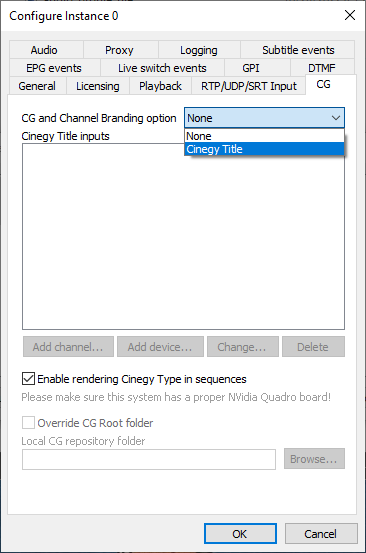CG
Reading time ~4 minutes

Select the corresponding option from the "CG and Channel Branding option" drop-down list to define whether graphics scenes will be sent to playout:
-
None – disable CG and Channel Branding option;
-
Cinegy Title – enable playout of new Cinegy Title graphics.
ImportantRefer to the Cinegy Title Manual for more information on working with the Cinegy Title application.
If a playlist contains Sequences with outdated Cinegy Type templates, select the "Enable rendering Cinegy Type in sequences" option. This enables the Cinegy Type templates playback and proxying.
|
Note
|
Please, make sure your system has the proper NVIDIA Quadro video board installed for the correct work with Cinegy Type scenes. |
|
Note
|
If Cinegy Type templates are not used, the "Enable rendering Cinegy Type in sequences" option should be disabled. |
|
Caution
|
In case the dongle is missing or the "Core Engine" license is missing, the Cinegy Playout will work in demo mode. If other license required for work is missing, the Cinegy Playout will not start. |
Cinegy Title Inputs
Cinegy Title supports live streams, SDI video inputs, and NDI inputs as RGBA (with alpha channel support), making them available as a texture in a scene. The channel configuration is similar to the one described for playback configuration.
Press the "Add channel" button to start configuring channels along with the required input devices.
Setting the Device ID Number
When the initial device is added, its ID number will be 0. Subsequently added new devices will have ID numbers 1, 2, etc.
For the Key&Fill mode setup, add two separate channels for key and fill signals and configure them correspondingly. Then the numbers of input channel instances should be correctly defined in the "Plate" object parameters.
Cinegy CG Root Folder
The Cinegy Playout engine serves as a tool for real-time graphics rendering, which means that it must have access to the folder containing CG templates and their media. Depending on the environment and requirements, you may want to place all CG templates in a single network location serving all users and playout machines at once, or – for better reliability – copy these templates across all playout machines to make them independent from possible network failures.
CG templates may also have relative paths for the embedded media items (images, video files), and when these templates are moved between locations, neither preview nor playback will work until every template has a valid root path – the so called CG root folder. To avoid this, you can define the Cinegy CG root folder explicitly on every playout machine, overwriting in such a way any "root" path value within a CG scene.
The Cinegy Playout engine will read CG templates from the defined Cinegy CG root folder too.
Here is an example. A designer creates a CG scene in a folder on his drive S:, and this scene references to an image via the relative path ".\media\image.png". When ready, this scene is copied to a different network location (\\Share\CG_Folder) or to the playout machine directly (drive D:\CG_Folder), but Cinegy Playout cannot find this image unless there is the drive S: with exactly the same folder containing this image file.
For correct playback of this CG scene via Cinegy Playout, you can either add local drive S: with exactly the same folder in it or simply specify a new CG templates folder and configure Cinegy Playout to refer to the different location using the "Override CG Root folder" option.
As the result, the Cinegy Playout engine will read CG templates either from \\Share\CG_Folder or the local drive D:\CG_Folder and image file either from \\Share\CG_Folder\media\image.png or D:\CG_Folder\media\image.png accordingly.
|
Note
|
It is not recommended to use single network location for all CG templates in order to avoid frame rendering delays on the playout machines in case this location becomes unavailable. |
|
Important
|
Refer to the Plate object description in the Cinegy Title Manual for more information about relative paths. |